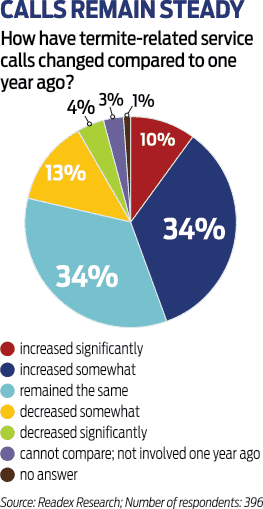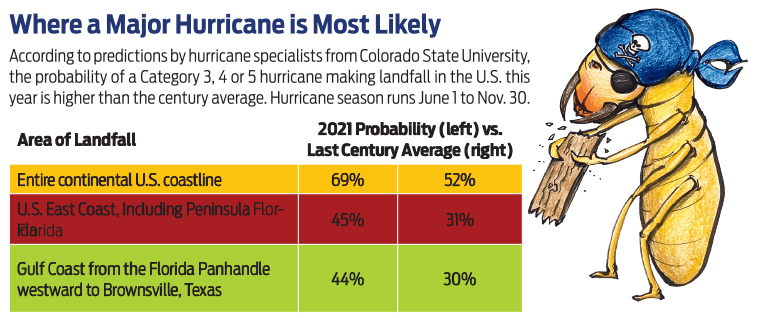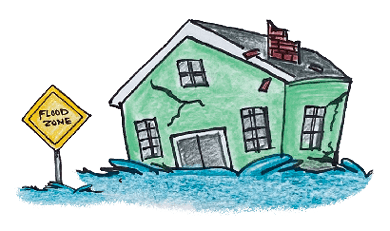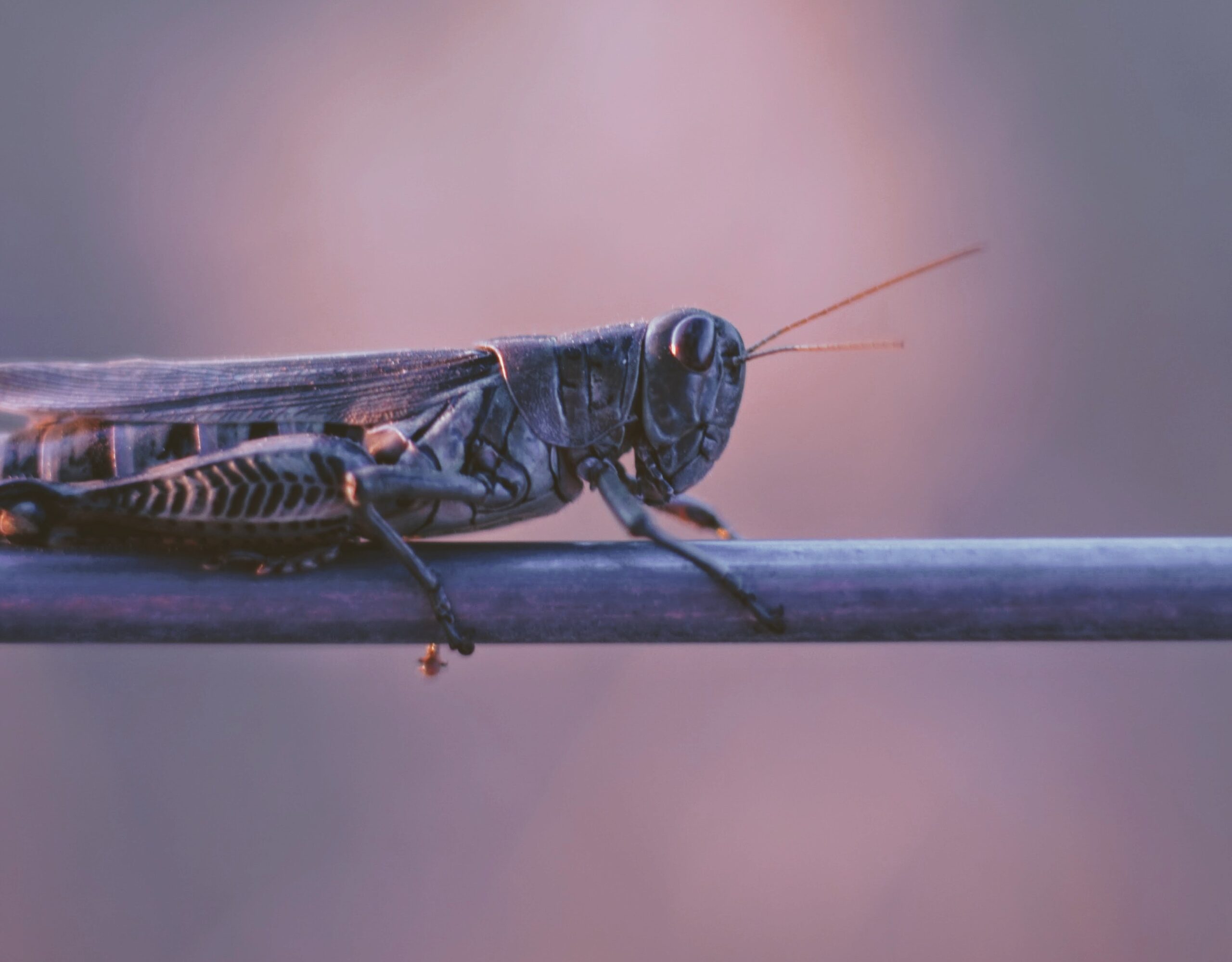Last year’s Atlantic hurricane season broke records with 30 named storms and 12 storms making landfall in the continental United States.
It was such an active season that the National Oceanic and Atmospheric Administration (NOAA) exhausted its list of 21 storm names by mid-September. The agency identified subsequent tempests by letters of the Greek alphabet, which it had only done once before in its history (see related story on page 26).
Unfortunately, 2021 is expected to be another above-normal hurricane season. Meteorologists at Colorado State University who specialize in seasonal hurricane forecasts predicted 17 named storms, eight hurricanes and four major hurricanes for the Atlantic basin this year.
Hurricanes typically make landfall in the Southeast and along the Gulf Coast; these are areas that also have the highest termite pressure in the country. This begs the question: How do the storms affect termite control efforts — and even the pests themselves? We asked the experts.
Can Termites Survive a Hurricane Flood?
Yes and no. If flooding is extensive and of long duration, subterranean termites will drown.
“They do not move above ground to avoid surging ground water levels; they prefer to sit and wait it out,” said Gregg Henderson, an industry consultant and emeritus professor of entomology at Louisiana State University.
Research conducted in 1995 by Henderson and Brian Forschler, an entomologist at the University of Georgia at Athens, found inundation, or flooding, was the single-greatest natural factor that led to mortality of subterranean termite populations.
Termites can survive one to three days of inundation by entering a state of dormancy but will drown after about four days underwater, explained Forschler.
But even when many termites die of drowning, the colony likely will survive. “If you have a termite colony that’s three million strong and you kill off 100,000, then they’re going to bounce back,” said Carrie Cottone, principal research entomologist at the New Orleans Mosquito, Termite & Rodent Control Board.
Mark Janowiecki, a research entomologist who works with Cottone, found this to be the case with Eastern subterranean termites. He tracked the native termites for two years in a forested area flooded by Hurricane Harvey, which hit Southeast Texas in 2017. The flood affected the termites, but not profoundly. “There was a sharp decline in the foraging, but it balanced out after a few months,” he said.
Formosan termite colonies have an advantage when it comes to flooding. Research conducted by Cottone in 2015 found these termites can survive up to three weeks of inundation if they can find air pockets in their underground nests.
“The Formosan termites have a very defined, well-formed carton nest that is more resistant to flooding so they’re able to withstand the flooding better,” explained Janowiecki. The nest of the native Eastern subterranean termite, on the other hand, is less defined, so these termites are more susceptible to drowning, he said.
Not all termites are threatened by hurricane flooding. “Areas that stay underwater for more than a few days will kill a lot of termites, but any that were above ground — in a tree bole or structure — will survive,” said Forschler.
Illustrations by Sean Burris
Do Hurricanes Spread Termites?
To some degree. “A storm is not really going to blow termites around for dispersal purposes; the termite’s biology just doesn’t allow that type of dispersal,” said Henderson.
But critters in infested wood from structures and trees can get transported to new areas by humans during clean-up and disposal of storm debris.
“We are wonderful at spreading these guys around and that is a major factor” in their ability to get established in new areas, said Cottone. As such, New Orleans requires the inspection of construction goods to ensure Formosan termites are not unknowingly transported to other parishes. Even so, the pests may be spread by people selling boats and outdoor furniture that they don’t know are infested on online marketplaces, she said.
It is possible termites may get pushed to new locales by the storms. A 2017 study by an international group of researchers who examined the mitochondrial DNA of termites suggests that about 35 million years ago the insects gained access to new lands by crossing oceans from one continent to another on floating logs.
Do Hurricanes Cause More Termite Activity?
They may. “Hurricanes can damage trees and structures and make them more vulnerable to termite attack,” said Henderson.
The storms put more wood in contact with wet surfaces and allow water intrusion into roof-damaged homes; subterranean termites are attracted to wet wood, causing them to move above ground. Formosan termites may build carton nests above soil, making remedial control more difficult, he explained.

Storms also can create an abundance of “termite food” like dead trees and stumps, which could cause termite activity to increase some five to 10 years later as the populations grow, said Forschler.
And fragments of termite colonies displaced by storms, such as during clean up, could grow large enough in size in four to six years to cause noticeable damage in new areas, said Janowiecki.
Gillen Pest Control Sales Manager Ted Lieb said termite activity significantly increased in his market three years following the flooding of Hurricane Harvey.
His sales of termite baiting systems doubled in 2020, but the increase wasn’t from pushing preventive termite services. “These sales were all because people had active termites,” said Lieb, who was “finding actual termites at sites way above what we normally would. Finding termite damage and termite activity is what doubled. There’s definitely been a change in the actual amount of active termites found,” he said.
Researchers, however, said no scientific evidence exists to show that termite activity spikes several years after a major flooding event; no long-term studies of this kind have been conducted.
Instead, a post-hurricane increase in termite calls is likely due to other factors, they said.
Immediately following a storm, termite damage is more noticeable as people pull up floorboards and rip out sheetrock during clean-up and repair of damaged structures. This exposes hidden termite activity and can cause an increase in termite control calls.
Formosan termites, which infest living trees, also may appear to increase in numbers when storm-damaged trees readily reveal their presence, added Henderson.
The real estate market is another factor. A “significant upswing” in Houston-area real estate transactions led to a 15 percent increase in termite work last year for Modern Pest Control, said Del Lawson, vice president of operations for the company. Wood-destroying insect reports required for closings found termite activity that needed treatment, he explained.

Illustrations by Sean Burris
The Katy, Texas-based company saw a quarter of its service area flood during Hurricane Harvey. “I don’t know that the flood made any difference, but what I do know is that our termite market in Houston is growing. That’s the one thing we can say for sure,” said Lawson.
The COVID-19 pandemic also turned homeowner attention to termite activity. Two-thirds (66 percent) of PMPs said customers became aware of termite issues sooner than in the past because they were spending more time at home due to the pandemic, according to the 2021 PCT State of the Termite Control Market survey, which was sponsored by BASF and conducted by Readex, an independent research company. As a result, 44 percent of PMPs said calls for termite service increased in 2020 compared to the year prior.
Daniel Shank, owner of Broken Arrow Pest Control in Livingston, Texas, north of Houston, thinks termite populations may have come back last year after being diminished by Hurricane Harvey flooding. His termite control sales dropped in 2018 and 2019, then increased last year back to pre-Harvey 2017 levels.
Do I Need to Take Extra Termite Precautions After a Hurricane?
Probably, although a lot depends on the severity of the storm.
“Most important is to maintain an active inspection system after a hurricane,” said Henderson.

Illustrations by Sean Burris
Flood Facts
>> Hurricane Harvey dumped more than three feet of rain on Southeast Texas in August 2017, causing catastrophic flooding and swamping 300,000 structures (NOAA).
>> In 2005, 80 percent of New Orleans flooded after levees broke during Hurricane Katrina; parts of the city were submerged for 40-plus days (Encyclopedia Britannica).
>> Interestingly, termites in the levee system and deficiencies controlling them likely contributed to levee breaches in New Orleans, according to Gregg Henderson, Louisiana State University. His award-winning paper on the topic was published by American Entomologist in 2007.
An extra or early service visit can help ensure that bait stations aren’t washed away, covered in mud, or contaminated by ground chemicals, and don’t have fungus growth due to wet soil conditions.
And liquid termite treatments may need replacement if the soil remained saturated for too long or was washed away from the structure.
“I don’t know of any data that suggests that you can expect treatments to fail after a flood,” said Ed Vargo, an entomologist at Texas A&M University. “But certainly it wouldn’t hurt if there’s major flooding, there are structures under water, to check and make sure that the integrity of the ground around the structure hasn’t been compromised somehow,” he said.
Cottone urged pest management professionals to follow the recommendations of product manufacturers. They typically communicate the necessary steps, if any, to safeguard termite protection following a major weather event.
“It’s always best to defer to the manufacturer, and if they don’t reach out to you, then you need to reach out to them,” she said.
Do I Need to Get My Company Ready for Hurricane Season?
Most definitely. Organizations in hurricane-prone areas should have a disaster plan that is written and practiced so all employees know their roles and responsibilities.
“We had a lot of near misses last summer where we had to prepare our facility and our fleet for hurricane events,” said Cottone. As such, it’s good to know in advance exactly what must be done to prepare.
Changes for the 2021 Hurricane Season
Hurricanes no longer will be named after letters of the Greek alphabet.
According to the hurricane committee of the World Meteorological Organization (WMO), which serves North America, Central America and the Caribbean, the Greek alphabet names caused confusion when translated into other languages and some names (Zeta, Eta, Theta) sounded too much alike when storms occurred in succession.
This led to messaging challenges rather than streamlined, clear communications about hazard and storm warnings.
Instead, the committee will create a supplemental list of Atlantic hurricane names excluding names that start with Q, U, X, Y and Z, which are not common enough or easily understood in local languages.
The committee also retired four names from the rotating list of Atlantic tropical cyclone names because of the death and destruction they caused. These are Dorian, a category 5 hurricane that hit the Bahamas in 2019; Laura, a category 4 hurricane that made landfall in 2020 near Cameron, La.; and Eta and Iota, which struck Nicaragua and Honduras two weeks apart in 2020, causing extensive flooding.
In total, 93 names have been retired from the Atlantic basin list since 1953, when the current storm-naming system began. A name repeats every six years unless it has been retired.
Members of the WMO hurricane committee also decided to keep June 1 as the official start date of Atlantic hurricane season.
The National Weather Service’s National Hurricane Center in the U.S., however, said it will issue routine tropical weather outlooks starting May 15, since Atlantic tropical cyclones have formed prior to June 1 for the past six years.
A hurricane plan should include an updated product inventory. “If there’s a flood event, you know which manufacturers to reach out to and how to reach them,” said Cottone.
It also must address what to do with your fleet, from potentially moving vehicles to higher ground to fueling them up pre-storm since power outages may make pumping gas impossible. Have procedures to secure chemicals so they don’t get washed away and protect expensive, hard-to-replace electronics.
Be sure to save employee and customer data in the cloud or in secure locations so you can access it if your office is forced to shut down. Consider how you’ll stay in communication with employees if cell towers and communication systems are disrupted.
Pre-storm preparations should take place early to give employees enough time to prepare their own homes and families or to evacuate if necessary, advised Cottone.





:quality(70)/d1hfln2sfez66z.cloudfront.net/03-22-2020/t_46015203ea0d46be83b2802243d079df_name_82E4943CFDC2407EADEC5C6A00190050.jpg)

